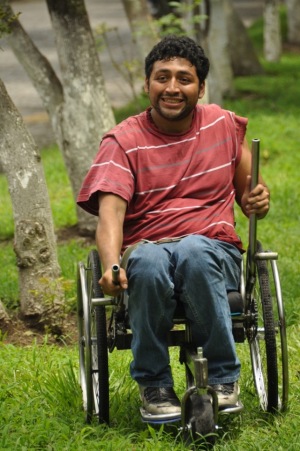Point of care: Let freedom roll
by
Olga Deshchenko, DOTmed News Reporter | January 04, 2011

LFC in action
This report originally appeared in the January 2011 issue of DOTmed Business News
Five summers ago, Amos Winter followed his girlfriend to Tanzania and returned with a newfound passion to revolutionize mobility for disabled people in the developing world.
During his summer public service fellowship, Winter, who now holds a doctorate in mechanical engineering from the Massachusetts Institute of Technology, worked on assessing wheelchair technology, interviewing numerous Tanzanians. Winter found that only 4 percent of Tanzanians who need wheelchairs actually have them and the traditional options that are available are not optimal for dealing with the rugged landscape.
He learned that hand-powered bicycles are more popular than standard wheelchairs on the often muddy, rocky or dusty roads. But even those devices fall short off road and indoors.
Fast forward to 2010 and Winter is talking about his work via a phone from Guatemala, where he spent the summer testing 30 wheelchairs that embody his design concept, thanks to a $50,000 grant from the Inter-American Development Bank.
In 2007, Amos founded the MIT Mobility Lab (M-Lab), a research and engineering lab, where students, designers and manufacturers collaborate on projects to improve the lives of the disabled worldwide. That’s where Winter and a group of students came up with the Leveraged Freedom Chair. Since its creation, the prototype has been tested in regions of Africa and Central America, with design advancements made through testing and feedback from users.
The LFC rivals traditional wheelchairs in efficiency on rough terrain because of its unique design. It’s powered by two long levers on each side. To accelerate, the user holds the levers low, near the axle. To slow down, the user holds the levers higher up, which generates a lot of torque.
“The wheelchair was designed to optimally convert the power and force output you have available in your upper body so you can travel most efficiently in the most common terrains but also have enough force to basically bench press your way out of trouble when you get into really rough terrain,” explains Winter.
All of LFC’s movable parts are made of inexpensive bicycle components. “The trick of the wheelchair is that it uses bike parts available anywhere and that really makes it serviceable and robust,” says Winter. “The person effectively shifts gears by just sliding their hands up and down the levers. People are good at doing complex mechanical motion and it’s much easier to have a person do it than a machine.”
|
|
|
You Must Be Logged In To Post A Comment
|
